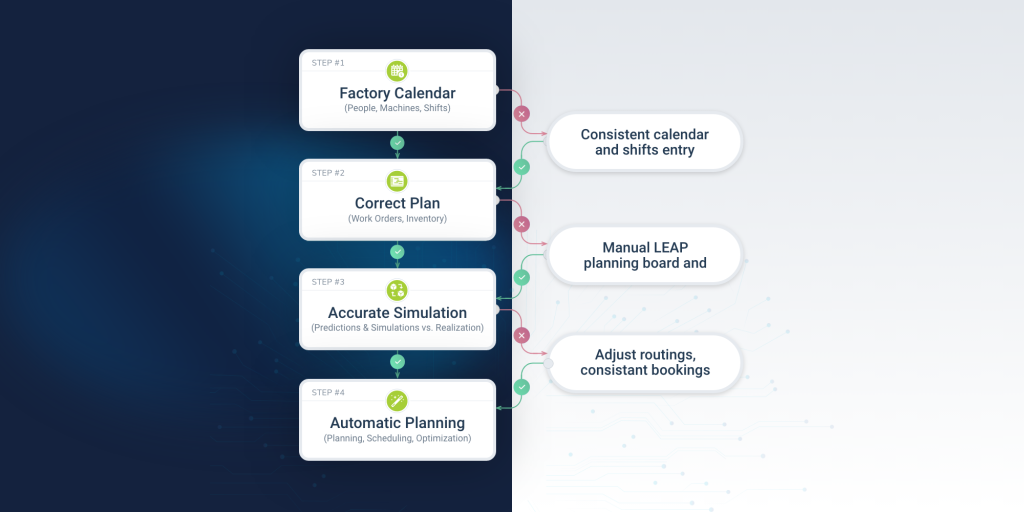While manufacturing companies lose millions due to static, outdated ERP normatives, Qlector LEAP brings together actual, historical, and normative data in real time to deliver realistic production time predictions and reliable production plans.
When we meet potential users at events or sales presentations, we almost always get the same question: What makes Qlector LEAP truly unique in the sea of AI solutions and buzzwords that often leave companies confused and stuck in FOMO, worried about missing out on opportunities?
This blog aims to explain why Qlector LEAP is a unique solution that continuously compares ERP master data normatives with actual shop floor performance from MES, using these insights to generate realistic production plans for the future.
From Work Orders to Realistic Production Plans
Qlector LEAP tracks execution across work orders and identifies whether production is running at, below, or above the ERP normatives. It considers both historical company data and ERP normatives, then uses advanced machine learning models to capture deviations between planned and actual performance. These deviations are directly incorporated into future production plans, making them more reliable and realistic.
In theory, companies should track actual production times and quantities and compare them against ERP normative data – for example, on a quarterly or semi-annual basis. In practice, this rarely happens, often due to conflicting interests and strategic negotiation dynamics.
Sales Conflicts
The first conflict typically arises with the sales department. Sales performance is closely tied to ERP normatives, which define expected time and material consumption and form the basis for cost calculations and sales prices. If the normatives are unrealistic, then the cost calculations are wrong, which distorts margin reporting and sales performance metrics. For that reason, sales teams are rarely willing to accept changes to ERP normative data unless top management is involved – a negotiation process that is typically slow and complex.
Union Conflicts
The second conflict often comes with labor unions. ERP master data normatives serve as a benchmark for expected worker productivity, defining how many units should be produced in a given time. They form the basis of wage systems, bonuses, and performance evaluations. If normatives are unrealistic, they fuel employee dissatisfaction, union disputes, and undermine fair compensation frameworks.
Why Realistic Plans Matter
With realistic production plans in place, companies can forecast material consumption, plan tool changes more accurately, and rely on actual cycle times and finished volumes. This is critical to maintaining high on-time delivery rates and keeping customers satisfied.
Automated Comparisons for Future Plans
The advantage of Qlector LEAP is that it automatically compares actual performance with ERP normatives and historical data—on a weekly or even daily basis. If production is consistently running above or below normatives, the model recognizes this and incorporates it into future plans, ensuring they are far more realistic.
The Key Differentiator
This is the key differentiator compared to other solutions. We call it the process digital twin of the factory. It is the heart of our solution – a powerful and sophisticated combination of data, machine learning methods, and algorithms. The crucial point is that this self-learning digital twin delivers actionable insights and realistic predictions for planners, instead of lagging deviation analyses that arrive too late to improve current plans and schedules.
Transparency and Visibility
Beyond predictions, Qlector LEAP also addresses the challenge of limited visibility in production planning. By creating a unified view of orders, resources, and constraints, it provides planners and managers with full transparency into what is really happening in production. This eliminates blind spots that cause inefficiencies, miscommunication, and misalignment across teams.
Optimized Work Order Sequencing
In addition, Qlector LEAP ensures that production runs are executed in the most efficient order. Its AI-driven optimization of work order sequences minimizes downtime, reduces unnecessary changeovers, and streamlines workflows. This transforms sequencing from a manual, error-prone task into an automated, intelligent process that significantly boosts on-time delivery and overall equipment effectiveness (OEE).
From Hidden Costs to Millions in Savings
It is difficult to understand why companies continue to rely on the illusion of ERP normatives in production planning—especially when it is clear that realistic predictions, full production transparency, and optimized sequencing provide far greater flexibility and proactive responsiveness to market changes and uncertainties.
At the same time, research and benchmark studies show that manufacturers lose 5–10% of annual revenue due to inefficient planning. Even modest improvements – and the benefits unlocked by Qlector LEAP – can generate millions in savings.
Seamless and Strategic
Since production planners cannot directly change ERP normative data themselves, our solution eliminates the need for exhausting negotiations between management, sales, and unions – seamlessly providing a strategically acceptable solution for all stakeholders.
Calculate Your Hidden Costs
By implementing Qlector LEAP, manufacturers gain an automated, technologically advanced, and strategically sound solution to a problem that has long burdened production planners. To help companies clearly see the financial impact of inefficient planning, we also provide an easy-to-use Hidden Costs Calculator that quantifies hidden losses and highlights the potential savings achievable with Qlector LEAP.
Book Your Free Consultation
If you’d like to find out exactly what hidden costs inefficient planning may be causing in your factory – or if you simply want to explore the opportunities that intelligent production planning can unlock for you – book your free introductory call here.












